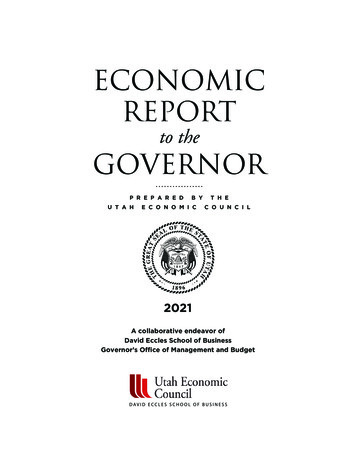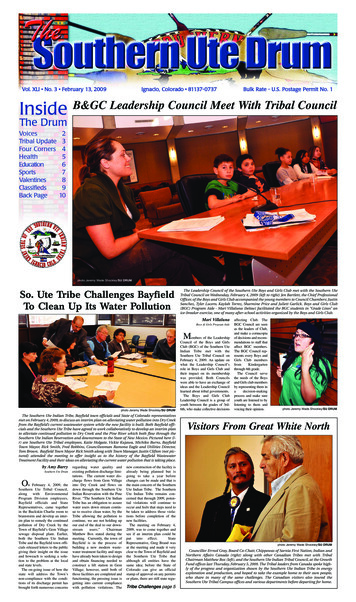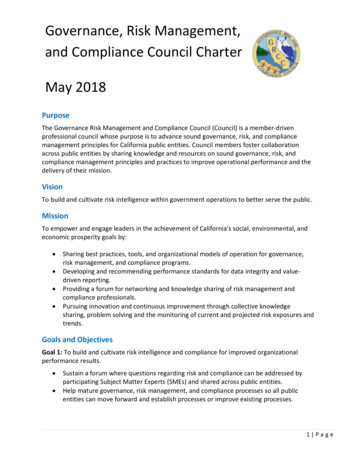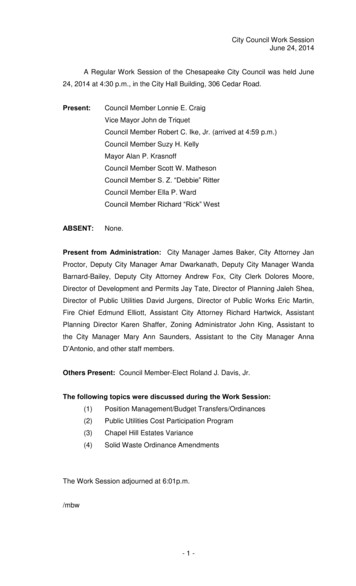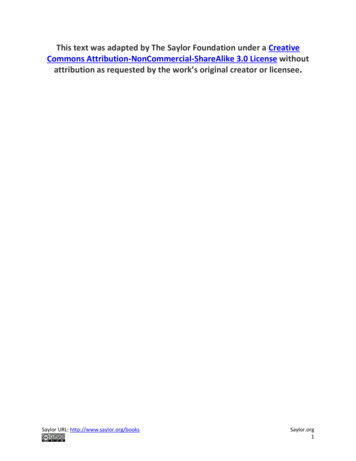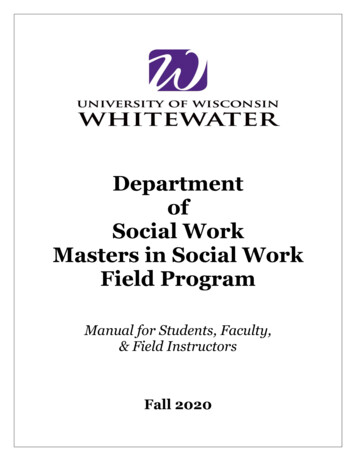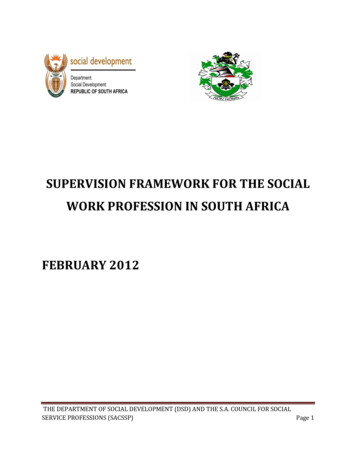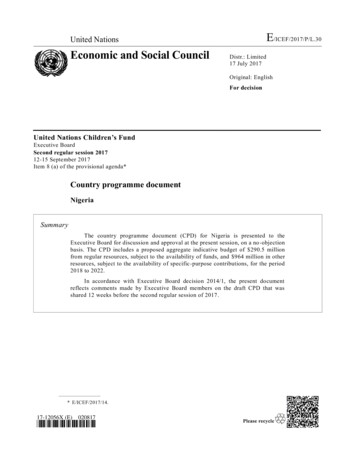
Transcription
E/ICEF/2017/P/L.30United NationsEconomic and Social CouncilDistr.: Limited17 July 2017Original: EnglishFor decisionUnited Nations Children’s FundExecutive BoardSecond regular session 201712-15 September 2017Item 8 (a) of the provisional agenda*Country programme documentNigeriaSummaryThe country programme document (CPD) for Nigeria is presented to theExecutive Board for discussion and approval at the present session, on a no -objectionbasis. The CPD includes a proposed aggregate indicative budget of 290.5 millionfrom regular resources, subject to the availability of funds, and 964 million in otherresources, subject to the availability of specific-purpose contributions, for the period2018 to 2022.In accordance with Executive Board decision 2014/1, the present documentreflects comments made by Executive Board members on the draft CPD that wasshared 12 weeks before the second regular session of 2017.* E/ICEF/2017/14.17-12056X (E)020817*1712056*
E/ICEF/2017/P/L.30Programme rationale1. Children and women in Nigeria face multiple deprivations and challenges, manyrooted in poverty and inequality, which in the north-east are exacerbated by the ongoinghumanitarian crisis. Millions of Nigerian children are vulnerable to disease, malnutrition,lack of education and numerous violations of their rights.2. In 2014, the population was estimated at almost 180 million, making it the mostpopulous nation in Africa (and seventh worldwide). Growing at 3.2 per cent annually andwith an estimated birth cohort of 7 million children, the population is estimated to reach200 million by 2020 and 400 million by 2050. Approximately 45.7 per cent of thepopulation is under age 15 and 17.1 per cent under age 5. Women of childbearing age (1549 years) account for 22.5 per cent of the population.13. Nigeria has the largest economy in West Africa, with 41 per cent of the region’s grossdomestic product. Economic growth has not resulted in shared prosperity, equitable socialprogress and environmental protection. About a third of Nigerians live below the povertyline. UNICEF estimates child poverty at 75 per cent (and reaching 90 per cent in somenorthern states). The Government is committed to achieving the Sustainable DevelopmentGoals and implementing reforms towards inclusive growth and sustainable development.Nigeria is at the cusp of a potential demographic dividend that could increase economicgrowth over the coming decades if strategic investments are made in health, education,empowerment of women and girls, job creation and good governance.4.The maternal mortality ratio is estimated at 576 per 100,000 live births, 2 accountingfor 10 per cent of the global burden of maternal deaths. According to the 2013Demographic and Health Survey (DHS), the infant and under-five mortality rates were 69and 128 per 1,000 live births, respectively. Neonatal mortality accounts for 262,000 deathsannually, the second highest national total globally. Malaria, pneumonia and diarrhoeatogether account for 64 per cent of under-five deaths. Despite investments in the sector,access to appropriate treatment remains low.5. Malnutrition is a direct or underlying cause of 54 per cent of all deaths of under-fivechildren. Nigeria has the second highest burden of stunted children, with a nationalprevalence of 32 per cent3 and 11 million children under age 5 affected. Currently decliningat an annual average rate of 3.1 per cent, Nigeria is not on track to achieve the SustainableDevelopment Goal target of a 40 per cent reduction by 2025, for which the rate of declinemust increase to 5.5 per cent. An estimated 2.5 million children suffer from severe acutemalnutrition (SAM), with only 20 per cent treated annually. Seven per cent of women ofchildbearing age suffer from acute malnutrition. Exclusive breastfeeding rates have notimproved significantly over the past decade, with only 17 per cent of infants exclusivelybreastfed during the first six months of life. Only 18 per cent of children aged 6-23 monthsare fed the minimum acceptable diet.6. Nigeria has the world’s second highest HIV burden; 3 per cent of the adult populationis HIV-positive and an estimated 3.4 million Nigerians are living with HIV. In 2015, some260,000 children aged 0-14 years were living with HIV and an estimated 41,000 new1United Nations country team, Nigeria Common Country Analysis Report, 31 October 2016.DHS 2013.3National Bureau of Statistics, National Nutrition and Health Survey 2014.22/17
E/ICEF/2017/P/L.30infections occurred among children aged 0-14 years, 90 per cent of them through motherto-child transmission.7. In 2015, an estimated 160,000 adolescents aged 10-19 years were living with HIV,with girls disproportionately affected, accounting for 70 per cent of all new infections inthis age group. Adolescents are the only age group for which AIDS-related mortalitycontinues to rise. Reported drivers include multiple and concurrent sexual partnerships,intergenerational sex, sexual coercion, low risk perception and transactional sex.48. The primary health care (PHC) system has not functioned well for decades, withbottlenecks in delivery including a lack of necessary commodities, equipment and skilledand motivated workers; challenges in access in remote areas, including lack of deliverypoints and a referral system; the cost and perceived poor quality of services; lack ofawareness of service availability; and inadequate community mobilization. TheGovernment has launched the ‘one PHC centre per ward’ strategy, which aims to revitalizePHC through the establishment or rehabilitation of up to 10,000 PHC centres, one in eachadministrative ward.9. After two years of no cases of polio in Nigeria, in mid-2016 four cases wereconfirmed in Borno State. UNICEF and partners supported the Government in a majorimmunization campaign in the Lake Chad Basin area to vaccinate over 41 million childrento contain the outbreak. To reach the thousands of inaccessible children in Borno, theprogramme continues to focus on gaining access and building trust with affectedpopulations, including internally displaced persons (IDPs).10. Nigeria ranks among the top three countries with large numbers of people withoutaccess to safe water and improved sanitation, and practicing open defecation. Low coverageof water and sanitation services is coupled with limited institutional and human resourcecapacities, especially at state and local government area (LGA) levels. Poor access to water,sanitation and hygiene (WASH) is directly linked to incidences of diarrhoea, whichcontributes to the high child mortality rates. As of 2015, 57 million Nigerians were withoutaccess to improved water sources and another 130 million people without access toimproved sanitation. An estimated 25 per cent of Nigerians practice open defecation on adaily basis. Access to WASH in schools and health centres continues to be low.11. Nigeria accounts for more than one in six out-of-school children globally. Althoughprimary education is officially free and compulsory, 10.1 million children aged 5-14 yearsare not in school.5 Seventy-four per cent of out-of-school children of primary school age areexpected never to enter school. Only 67 per cent of 6-11-year-olds regularly attend primaryschool. The pre-primary participation rate is 60 per cent, with gross attendance rates of 24per cent in the north.612. Gender, like geography and poverty, is an important factor in the pattern ofeducational marginalization. States in the north-east and north-west have female primarynet attendance ratios of 41.2 per cent and 47.1 per cent, respectively, meaning that morethan half of girls are not in school.74Joint United Nations Programme on HIV/AIDS, Global AIDS Update 2016; National HIV/AIDS StrategicFramework 2010-2015.5UNICEF and UNESCO Institute for Statistics, Nigeria Country Study, March 2015.6National Population Commission (NPC), Nigeria Education Data Survey, 2015.7Ibid.3/17
E/ICEF/2017/P/L.3013. Education indicators for northern Nigeria are the most challenging, driven by socialattitudes towards formal education, especially for girls, difficulties in ensuring educationalprovision in predominantly rural LGAs and the impact of insurgency in the north-east. InBorno, 74.8 per cent of children aged 4-16 years have never attended school. In northeastern and north-western states, 29 per cent and 35 per cent of Muslim children,respectively, attend Qur'anic education, 8 which does not include basic education skills suchas literacy and numeracy. These children are officially considered out-of-school by theGovernment. Nearly half of all children who have completed primary school cannot read acomplete sentence.9 Poor learning outcomes are caused by low levels of teachingcompetence, lack of instructional materials, poor student attendance and lack of safe,inclusive classrooms. Children do not learn the skills that would enable them to functioneffectively or earn a decent livelihood.14. Nigerian children experience a wide range of abuses and harmful traditional practices.The national legal framework for child protection is the Child Rights Act 2003. To date, 23of 36 states have domesticated the Act (which is required for entry into force at state level).Yet implementation remains limited as most mandated bodies are unaware of their dutiesunder the law. A national survey in 2014 found that 6 in 10 children reported havingsuffered suffer one or more forms of violence before reaching 18 years of age, with over 70per cent experiencing multiple incidents of violence. 1015. Nigeria has the largest number of child brides in Africa: 23 million girls and womenwere married as children. Currently, 43 per cent of girls are married before they turn 18 and17 per cent before they turn 15.11 While the drivers are complex, child marriage most oftenoccurs in poor, rural communities. At 27 per cent, the prevalence of female genitalmutilation/cutting (FGM/C) among girls and women aged 15-49 years is lower than inmany countries where the practice is carried out, but Nigeria still has the third highestabsolute number of women and girls (19.9 million) who have undergone FGM/Cworldwide. It is more commonly practiced in the south, driven by grandmothers andmothers-in-law aiming to curb promiscuity, prepare girls for marriage and conform totradition.1216. An estimated 62 per cent of births are unregistered. A 2016 national campaign linkedto health-care services resulted in the registration of about 7 million children, but progresshas been impacted by the country’s enormous population growth. Barriers include aninsufficient numbers of registrars; regular stock-outs of birth certificates; lack of publicawareness of the importance of birth registration; ingrained socio-cultural beliefs; andparallel systems for birth registration at federal and LGA levels.17. Over the past six years, the armed conflict in the north-east has affected civiliansalready living in precarious conditions, undermined poverty reduction and developmentefforts, strained government resources and depleted community coping capacities.Adamawa, Borno, and Yobe States have been disproportionally affected. As of 31 January2017, an estimated 8.5 million people were in need of humanitarian assistance, including8Ibid.NPC, Nigeria Education Data Survey, 2015.10NPC, UNICEF and the United States Centers for Disease Control and Prevention, ‘Violence AgainstChildren in Nigeria: Findings from a National Survey 2014’, February 2016.11A profile of Child Marriage in Africa, UNICEF, New York, 2015.12UNFPA/UNICEF, Baseline Situation Assessment FGM/C: Analysis of social norms to inform strategiesfor the implementation of UNFPA/UNICEF Joint Programme on FGM/C abandonment in Nigeria, 2015.94/17
E/ICEF/2017/P/L.301.78 million IDPs.13 The UNICEF Executive Director activated the UNICEF Level 3Corporate Emergency Procedure for north-east Nigeria in August 2016. What started as aprotection crisis is also developing into a nutrition crisis, with an estimated 3.9 millionpeople currently food insecure, 38,000 people facing famine-like conditions in Borno Stateand close to 450,000 children are at risk of SAM across the three states in 2017 (300,000 inBorno alone).1418. The health, education and WASH sectors have also been impacted by the crisis. Anestimated 200 of 450 health facilities have been destroyed, along with 75 per cent ofWASH infrastructure. Some 3.6 million people lack access to safe water, 1.9 million peoplelack access to basic sanitation and 6.2 million people are without proper hygiene due to thehigh rate of open defecation and low rates of hand-washing.15 Since 2011, an estimated19,000 teachers have been displaced, 1,200 schools damaged or destroyed and 3 millionchildren deprived of education.19. Children have been acutely affected by conflict. Following the listing of Boko Haramfor the killing and maiming of children and attacks on schools and hospitals, Nigeria wasincluded in the report of the United Nations Secretary-General (A/68/878-S/2014/339). Themonitoring and reporting mechanism (MRM) on children and armed conflict was initiatedin December 2014. In June 2015 and April 2016, respectively, Boko Haram and theCivilian Joint Task Force were listed in the annexes of the Secretary-General’s annualreports for the recruitment and use of children. Since 2009, at least 7,000 girls and womenhave been subjected to Boko Haram-related sexual violence.1620. Epidemics, intercommunal conflict and natural hazards, particularly floods, also occurin Nigeria. The worst flooding in 50 years occurred in 2012, killing 431 people and leavingover 1 million people displaced. The floods exposed weaknesses in the country’s responsecapacity, hence the focus on supporting the Government to strengthen preparedness andrisk-informed programming, including conflict and disaster risk reduction (C/DRR).Cholera is endemic; a resurgence in 2014 and 2015 resulted in nearly 42,000 cases andalmost 1,000 deaths.Programme priorities and partnerships21. The Federal Government’s Economic Recovery and Growth Plan, 2017-2020 aims todiversify the productive base of the economy and direct it towards sustainable developmentand inclusive growth. The United Nations Sustainable Development PartnershipFramework (UNSDPF), 2018-2022 is closely aligned with the national plan, which formsthe basis for the development of Nigeria Vision 2030 and aligns the country’s milestones tothe Sustainable Development Goals and the African Union Agenda 2063. Nigeria is a“Delivering as one” country, and UNICEF has chaired the development of the newUNSDPF.22. The vision for the next country programme of cooperation, which is in the spirit of thedraft UNICEF Strategic Plan, 2018-2021 and geared towards achievement of the13OCHA Nigeria Humanitarian Response Plan 2017, December 2016.Population of children under age five years projected 2006 census data; National Nutrition and HealthSurvey 2015.15OCHA, Nigeria Humanitarian Needs Overview 2017, November 2016.16United Nations, Report of the Secretary-General on children and armed conflict in Nigeria, S/2017/304,10 April 2017.145/17
E/ICEF/2017/P/L.30Sustainable Development Goals, is to demonstrate the impact, value and affordability ofinvesting in long-lasting institutional and community-based systems and policies in favourof children’s survival, growth and development. This strategy pursues nationwide universalcoverage based on replicable models established in selected focus states and LGAs, whileensuring the provision of rapid life-saving humanitarian assistance. UNICEF aims toaccelerate progress in four high-impact areas of results for children where it is uniquelyplaced to support the Government:(a) Enrolment of children, especially girls, in early learning and primary school atthe right age to promote psychomotor and cognitive development in order to reduce thenumber of out-of-school children; strengthen gender equality in and through education; andimprove the quality of learning for retention;(b) Routine immunization, including against polio, for all children by 1 year of ageand support for women to make informed and empowered decisions, including duringpregnancy, to promote child survival and well-being;(c) Feeding, hygiene and sanitation practices to reduce high levels of stunting andprevent and treat SAM in under-five children;(d) Promotion of attitudes and practices to reduce the high prevalence of violenceagainst children and address gender norms at all levels of society.23. Underlying this approach will be better cross-border collaboration with neighbouringcountries, especially in the Lake Chad Basin, and support towards achieving theSustainable Development Goals, which is critical given the country’s demographic weight.24. Important lessons learned informing this approach are that targeting of focus statesand LGAs needs to be better coordinated and more strategic, and that geographic andprogrammatic convergence are needed to harness gains for children. Using strengthenedcriteria for selecting focus states and LGAs, UNICEF will connect policies at the nationaland state levels with capacity-strengthening efforts at selected local levels, which willsimultaneously generate demand for services. This will be complemented by thedevelopment of coordinated data systems, evidence-based investment cases and proof-ofconcept models.25. Within selected states, LGAs and wards will be critically important units ofmanagement. The approach will build on four existing programme delivery systems: (a)PHC centres, incorporating community management of acute malnutrition (CMAM)services; (b) WASH committees; (c) school-based management committees; and (d) childprotection units. UNICEF will accelerate results more cost effectively by identifyingopportunities for programme convergence wherever feasible through these delivery systemsand sectoral entry points and focusing on key levers for implementation. Partnership withthe Government, non-governmental organizations (NGOs), civil society and the privatesector will be leveraged, and innovation and social mobilization will be strategicallyharnessed for exponential change. The programme will work at the decentralized state andLGA levels in the delivery of services, capacity-building and programme monitoring.Child survival and development26. High mortality and malnutrition rates make strengthening and refocusing childsurvival and development interventions a humanitarian imperative. Four subcomponentswill address the interrelated areas of health, nutrition, WASH and HIV/AIDS, aligned toSustainable Development Goals 2, 3 and 6.6/17
E/ICEF/2017/P/L.3027. Health. The programme will focus on supporting the federal and state governments to:(a) operationalize the ‘one PHC centre per ward’ strategy for achieving universal healthcoverage; (b) continue the focus on polio eradication and the polio end-game strategy; (c)strengthen routine immunization nationwide, including vaccine security, and contribute toother accelerated disease control strategies, including polio eradication and measleselimination; and (d) foster women’s capacities and authority for decision-making aboutchildren’s health. UNICEF will support direct implementation of PHC revitalization ineight states.28. The programme will advocate and support strengthened political commitment,accountability and government capacities to legislate, plan and budget for expanding healthinterventions. The ‘One PHC centre per ward’ strategy aims to have, in all 10,000administrative wards, a functional PHC centre with the capacity to deliver a qualityintegrated minimum care package for control of communicable diseases; child survivalinterventions that prioritize the main childhood killers; maternal and newborn care;nutrition; non-communicable disease prevention; health education and communitymobilization. UNICEF will provide capacity-building and technical support to state-levelstakeholders to develop implementation and acceleration plans; assist in the rehabilitationof PHC facilities and train staff in integrated, equity-focused and gender-sensitive maternal,newborn and child health services; support institutionalization of maternal and perinataldeath surveillance and response; and leverage resources to ensure availability of basiccommodities. Communication for development strategies will promote improved healthseeking behaviours.29. Strengthening routine immunization and polio eradication will receive concertedattention, including through comprehensive multi-year immunization plans, andoptimization of the cold-chain system and procurement services for vaccines andconsumables. Because support from Gavi, the Vaccine Alliance, will be discontinued in2021, UNICEF and other partners will assist the Government in transition planning andadvocate for government self-financing for vaccines and immunization. The Bill & MelindaGates Foundation continues to be a critical partner for polio eradication.30. UNICEF will continue to foster partnerships, coordinated efforts and institutionalcapacity for emergency preparedness, response to epidemics and C/DRR.31. Nutrition. The programme will support the Government to implement the NationalPolicy on Food and Nutrition by strengthening health and community systems and fullyintegrating nutrition into all aspects of the PHC system, with a particular focus on CMAM,infant and young child feeding interventions and routine micronutrient supplementation.There will be specific focus on aligning nutrition interventions with antenatal care,prevention and control of pneumonia and diarrhoea, immunization, deworming anddistribution of insecticide-treated mosquito nets, and adolescent girls’ and maternalnutrition. UNICEF programming will complement the efforts of other United Nationsagencies, with nutrition-sensitive interventions geared towards the sustainable shift fromemergency to development with long-term nutrition interventions that address stunting andSAM. The United Kingdom Department for International Development (DFID) is animportant nutrition partner.32. With the growing potential for domestic funding of nutrition interventions, UNICEFwill increasingly focus on strengthening policies, government systems and accountability toensure adequate nutrition financing. Recognizing geographical differences in the scale ofmalnutrition, UNICEF will continue to support service delivery in the north while7/17
E/ICEF/2017/P/L.30increasing the scale and intensity of policy advice and advocacy at the federal and statelevels.33. Humanitarian nutrition assistance will continue in critically affected northern states.UNICEF will focus on increasing the ability of the Government and partners to coordinatethe sector, proactively identify risk factors for the nutritional status of the population, suchas poor harvest yields, worsening purchasing power or poor feeding behaviours, andimplement mitigation measures.34. WASH. The programme will support the Government in implementing the Partnershipfor Expanded Water Supply, Sanitation and Hygiene, a national collaboration aiming toeliminate open defecation by 2025 and providing access to basic water supply and basicsanitation (including hand-washing facilities with soap) to all rural inhabitants by 2030. Thepartnership was finalized by the Ministry of Water Resources with support from the WASHDevelopment Partners Forum, which UNICEF co-chairs with the African DevelopmentBank. UNICEF will continue to support the humanitarian needs of IDPs in the north-east byrestoring and/or expanding WASH systems for host communities and returnees, therebycontributing to early recovery.35. The programme will advocate for increased political commitment, accountability andlegislation for gender-sensitive WASH policies; formulate evidence-based plans; andcoordinate, monitor and mobilize resources for scaling up WASH interventions. It willsupport strengthening government capacities at national and subnational levels to: deliversafe, equitable, sustainable and affordable drinking water; eliminate open defecation andensure the safety and dignity of girls and women by involving them in design choices forfacilities; provide gender-sensitive and disability-inclusive access to WASH services inschools and PHC centres; foster increased community resilience to disasters/climatechange; provide better control of water-related disease outbreaks; and deliver basic WASHservices in humanitarian situations. The programme will employ a mix of targeted servicedelivery in focus LGAs; systems strengthening including scaling up the WASHManagement Information System (WASH-MIS); community engagement and women’sparticipation in WASH committees and in the management of WASH facilities; behaviourchange communication and hygiene promotion through schools; and expandingpartnerships with the private sector for market shaping and innovation.36. HIV/AIDS. The programme will support the Government in implementing the nationalplan to fast-track the HIV response for elimination of mother-to-child transmission of HIV,paediatric HIV treatment and adolescent HIV prevention, treatment and care to achieve the’90-90-90’ targets by 2020 and to end AIDS in Nigeria by 2030. UNICEF will combine anintensified programmatic response with policy advice and implementation support toaddress persistent bottlenecks in achieving HIV targets for pregnant women, mothers,children and adolescents. UNICEF will focus on selected states and LGAs with the highestunmet needs for children’s HIV programming and will facilitate effective use of evidenceand South-South exchanges.37. To strengthen community support systems, the programme will establish partnershipsto empower families with information, enabling them to adopt positive behaviours andincrease demand for HIV services. The programme will strengthen community-facilitylinkages to identify, link and retain HIV-positive pregnant women, children and adolescentsin care. UNICEF will foster community-based innovative approaches to identify the mostat-risk adolescents and facilitate linkages to high-impact prevention services. Theprogramme will support evidence generation on the importance of integrated programmingfor HIV and maternal, newborn, child and adolescent health; support strengthening of8/17
E/ICEF/2017/P/L.30systems for pregnant women and children living with HIV and the most vulnerableadolescents during emergencies; promote resilience, C/DRR and early recovery; andprovide technical support to develop adolescent-focused interventions and data-collectionsystems.Basic education38. The programme will support the Government in achieving Sustainable DevelopmentGoal 4, focusing on girls, capacity-building and addressing institutional barriers to policyimplementation, strengthening the enabling environment and education system with a focuson out-of-school children, targeted service delivery and the promotion of women’sparticipation in education management. Continued support will be provided forscholarships, especially targeting girls. Priority states are those under the Girls’ EducationProject Phase 3 (being implemented in partnership with DFID/UKAid and Educate A Childuntil 2019). Engagement in selected states will gradually shift to evidence generation,institution-building and policy design. Other states with poor education indicators will beidentified in consultation with government and development partners.39. At federal and state levels, the programme will support effective and timely planning,monitoring, collection and use of data for decision-making through capacity-building andtechnical support to develop costed, evidence-informed plans and strengthening of theEducation Management Information System (EMIS). To ensure that teachers have therequisite competencies and use gender-responsive pedagogy to deliver quality education tochildren, the programme will support capacity-building for pre-primary and primaryteachers and Qur’anic facilitators, and development and/or review of training content anddelivery strategies. It will support the Government to plan and implement an assessment oflearning outcomes with a focus on girls, in collaboration with the World Bank and theUnited States Agency for International Development (USAID). State capacities will besupported to provide pre-primary education under the Global Partnership for Education(GPE).40. Communities in selected states will be actively engaged in enrolling children at theright age and ensuring they attend school regularly through school enrolment drives,advocacy to promote girls’ education and community involvement in addressing socialnorms that are barriers to education, especially for girls. Support will be provided to schoolbased groups encouraging and supporting girls to stay in school and delay child marriage.The programme will continue to promote and support a safe learning environment tomitigate the impact of conflict on children, teachers and communities in conflict-affectedstates (partnering with the Government of Norway). Learning opportunities in life andvocational skills will be supported for conflict-affected adolescents. The programme willalso seek opportunities to engage in risk-informed programming and building resilience ofchildren, schools and communities through integrating C/DRR and peacebuilding intorelevant interventions.Child protection41. The programme aims to strengthen state-level systems to prevent and respond to childprotection vulnerabilities and violations. System strengthening focuses on supporting thefederal and six selected state governments to effectively plan, allocate resources,coordinate, monitor and evaluate child protection interventions around a common visionand legal mandate to end violence against children (including FGM/C, child marriage and9/17
E/ICEF/2017/P/L.30school violence) and promote birth registration of all children. Combining advocacy, policyadvice, technical assis
Government has launched the 'one PHC centre per ward' strategy, which aims to revitalize PHC through the establishment or rehabilitation of up to 10,000 PHC centres, one in each . Borno, 74.8 per cent of children aged 4-16 years have never attended school. In north-eastern and north-western states, 29 per cent and 35 per cent of Muslim .


